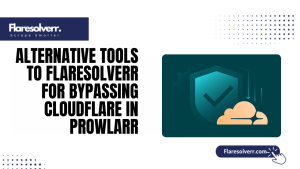Table of Contents
ToggleIntroduction
FlareSolverr is a handy tool for bypassing Cloudflare protections and making web automation easier. With flaresolverr windows, you can scrape websites or access APIs that typically block automated requests. It’s lightweight, fast, and works seamlessly with Docker, making it perfect for automated tasks. Portainer makes managing Docker containers intuitive and straightforward. Instead of using complex command lines, you get a friendly web interface to handle everything.
Overview of FlareSolverr in Web Automation
FlareSolverr Windows acts as a bridge between your scripts and websites with Cloudflare protection. It handles challenges and cookies automatically, so your requests go through without errors. Using it saves time and keeps your scraping workflow uninterrupted. With flaresolverr Windows install, you can automate repetitive web tasks safely. It supports multiple sessions and proxies, making it reliable for large-scale projects. By handling anti-bot protections, FlareSolverr simplifies complex automation needs effortlessly.
Why Use Portainer for Docker Management
Portainer is like a control center for your Docker setup. Instead of typing long commands, you can start, stop, or monitor containers with a few clicks. This makes managing flaresolverr Windows containers easier and more visual. It also supports container health checks, logs, and network management. When combined with flaresolverr Windows install, Portainer ensures your automation setup stays organized. You can track updates, configure ports and monitor performance with ease.
What is FlareSolverr and How Does It Work with Portainer?
FlareSolverr helps bypass Cloudflare and other anti-bot protections. With flaresolverr windows, it acts as a middle layer, handling requests and responses so your scripts can work without interruptions. It’s beneficial for web scraping or automation projects that require multiple sessions. Portainer complements this by providing an easy-to-use dashboard for managing Docker containers.
Understanding FlareSolverr’s Role in Bypassing Cloudflare
Cloudflare blocks automated requests by checking session and IP addresses. FlareSolverr Windows bypasses these checks by solving challenges and managing cookies automatically. This allows scripts to run uninterrupted and fetch the data you need. When you perform a FlareSolver Windows install, it integrates easily into Docker. The tool efficiently manages multiple requests, ensuring your automation doesn’t encounter roadblocks.
How Portainer Simplifies Docker Container Management
Portainer turns Docker from a command-line tool into a visual, easy-to-use platform. You can deploy containers, monitor health, check logs, and manage networks all from a browser interface. This is ideal for managing Windows containers with FlareSolver. After a flaresolverr Windows install, Portainer ensures your setup stays organized. You can track multiple containers, restart failed ones and even scale your services without touching the command line. It saves time and reduces human error.
Benefits of Using FlareSolverr with Portainer
Combining FlareSolver and Portainer offers seamless automation and simplified container management. FlareSolverr Windows handles anti-bot protections, while Portainer ensures your containers run reliably. This makes large-scale automation projects manageable and less stressful.With a proper flaresolverr Windows install, you also get easier updates and monitoring.
Preparing Your Environment for Setup
Before setting up FlareSolverr with Portainer, make sure your system has Docker installed. This is the foundation for running containers. With the flaresolverr Windows install, Docker provides a stable environment for the tool to function efficiently. Next, install Portainer to manage your Docker setup visually. FlareSolverr Windows runs inside Docker, so Portainer makes starting, stopping, and monitoring containers much simpler.
Installing Docker on Your System
Docker is essential for running FlareSolverr. Installing it creates a containerized environment where your flaresolverr Windows setup can operate smoothly. Docker ensures all dependencies are isolated and stable. After a flaresolverr Windows install, Docker lets you run containers consistently across different systems. It’s the backbone of this setup, preventing compatibility issues and simplifying future updates or migrations.
Installing Portainer for Docker Management
Portainer offers a user-friendly interface for Docker, simplifying container management. You can deploy, monitor, and configure your flaresolverr Windows containers without using command lines. Once you complete the FlareSolver Windows installation, Portainer allows for real-time monitoring and control. You can restart containers, check logs and manage networks effortlessly.
Setting Up Necessary Dependencies for FlareSolverr
FlareSolver requires certain dependencies, such as Node.js and specific libraries, to function correctly. During the flaresolverr windows install ensuring these are in place prevents runtime errors. Proper setup avoids failed requests and service crashes. Using Docker and Portainer simplifies dependency management.
Step-by-Step Guide to Setting Up FlareSolverr with Portainer
The first step is to pull the official FlareSolverr image from Docker Hub. Using FlareSolverr Windows Installer, Docker downloads a ready-to-use container with all dependencies included. This saves you time and avoids configuration headaches. Once the image is pulled, it’s ready for deployment. With flaresolverr windows, this image ensures your automation tasks can bypass Cloudflare without additional setup. Docker handles the isolation, so your system stays clean and organized.
Creating a FlareSolverr Container via Portainer
After pulling the image, open Portainer and create a new container. Name it clearly for easy identification. Using FlareSolverr Windows Installer, you can quickly spin up a container without dealing with complex commands. Portainer lets you customize your container settings, assign ports, and link volumes. With flaresolverr windows, you can run multiple containers for different projects simultaneously. This visual approach keeps your setup organized and manageable.
Configuring Ports, Volumes, and Environment Variables
Setting the correct ports ensures your FlareSolverr container communicates properly. Assign a port, such as 8191, to avoid conflicts. Using FlareSolverr Windows installer, ensure that environment variables are set, such as proxy settings or request timeouts. Volumes are essential for saving logs and configuration files. FlareSolverr Windows stores important data in these mapped folders, so updates or container restarts won’t cause data loss. Proper configuration ensures smooth operation.
Starting and Verifying the FlareSolverr Container
Once the container is configured, start it in Portainer. Check logs to confirm it’s running without errors. FlareSolverr Windows should initialize and be ready to handle requests immediately. Test the container by sending a request through your script. With flaresolverr Windows install, you can verify that it bypasses Cloudflare challenges successfully. This ensures your setup is complete and fully functional.
Common Issues During Setup and How to Fix Them
Sometimes ports are already in use by another service. If your flaresolverr Windows container fails to start, try changing the assigned port in Portainer. Check Docker and system logs to identify conflicts. With flaresolverr windows installed, adjusting ports ensures your container runs without blocking other applications. This is a straightforward solution to a common issue.
Network and Proxy Configuration Errors
Incorrect network or proxy settings can block FlareSolverr requests. Ensure your FlareSolver Windows container uses the correct proxy and network mode. Testing connections before running automation helps prevent failures. With flaresolverr windows installed, verify proxy authentication and routing to ensure smooth requests through Cloudflare-protected sites.
Container Fails to Start or Stops Unexpectedly
If the container crashes, check logs in Portainer. Missing dependencies or incorrect environment variables often cause failures. Using the FlareSolverr Windows installer, verify settings and update the image if needed. Restarting the container usually fixes temporary issues. With flaresolverr windows, regular monitoring prevents sudden downtime and keeps automation tasks running reliably.
Best Practices for Managing FlareSolverr Containers in Portainer
Monitoring your FlareSolverr containers regularly helps prevent unexpected downtime. FlareSolverr Windows provides logs that clearly show errors and performance issues. Checking these logs in Portainer ensures everything runs smoothly. Updating containers safely is essential. Always pull the latest image using FlareSolver Windows installer to get bug fixes and new features. Automating restarts and securing your Docker environment further enhances your setup’s protection.
Monitoring Logs and Container Health
Always check logs in Portainer for errors. FlareSolverr Windows provides detailed logs that help detect problems early. Monitoring ensures automation runs without interruptions. Health checks alert you if the container stops unexpectedly. With flaresolverr windows installed, this proactive approach prevents downtime and improves workflow efficiency.
Updating FlareSolverr Images Safely
Pull the latest Docker image regularly to fix bugs. Use FlareSolver Windows Installer to ensure updates include the newest features and security patches. Restart containers after updates and verify logs. Windows updates for FlareSolverr are usually smooth, but regular checks ensure everything runs seamlessly.
Automating Container Restarts
1.Enable automatic restarts in Portainer to recover from crashes.
2.With flaresolverr windows installed, containers stay active continuously.
3.Automatic restart policies save time and reduce manual intervention.
4.Ensures your automation tasks run smoothly 24/7.
5.Helps maintain workflow efficiency without unexpected downtime.
6.FlareSolverr Windows benefits from continuous operation and reliability.
Securing FlareSolverr and Docker Environment
Always use strong passwords and limit access to your Portainer interface. FlareSolverr Windows should not be exposed publicly without protection. Regularly review container permissions and network access. With flaresolverr windows install security practices to prevent unauthorized use and maintain a safe automation environment.
Advanced Tips for Optimizing Performance
Optimizing FlareSolverr performance ensures your automation runs faster and more reliably. Start by creating custom Docker networks to isolate containers. FlareSolverr Windows benefits from dedicated networks, which reduce conflicts and improve stability. Load balancing is another key strategy. Running multiple containers and distributing requests prevents overload. With flaresolverr windows installed, you can scale easily while maintaining smooth operations.
Using Custom Docker Networks
Creating custom Docker networks helps isolate FlareSolverr containers and improves overall stability. FlareSolverr Windows works best when network traffic is managed efficiently, avoiding conflicts with other containers or services. Separate networks keep your automation organized and reduce errors caused by overlapping ports or IPs. With flaresolverr windows install, this setup ensures consistent performance and reliable data flow. It also makes scaling easier if you add multiple containers for large tasks.
Load Balancing and Scaling Multiple Containers
Run multiple FlareSolverr containers and balance requests among them. This improves performance for large-scale automation. FlareSolverr Windows handles multiple sessions efficiently. Portainer makes scaling easy. With flaresolverr Windows install, you can deploy additional containers as needed without downtime or complicated setup.
Managing User Agents and Proxies Efficiently
Rotate user agents and proxies to prevent blocking. FlareSolverr Windows performs better with diverse request headers and IPs. Portainer lets you adjust environment variables for each container. With flaresolverr windows installed this keeps requests smooth and reduces the risk of detection or bans.
Conclusion
Setting up FlareSolverr on Windows with Portainer makes Docker management significantly more straightforward and stress-free. Once your FlareSolver windows installation is complete, monitoring, updating, and running containers become smooth and efficient. Using Portainer simplifies container control, while proper setup ensures stable performance. Following best practices keeping ports and proxies configured and regularly checking logs helps keep your FlareSolverr Windows running reliably without interruptions.
FAQs
How do I check if FlareSolverr is running correctly in Portainer?
Open Portainer and check the container status. If it shows “running” and logs show successful requests, FlareSolverr Windows is working fine.
Can I run multiple FlareSolverr containers simultaneously?
Yes, you can run several containers with different ports. This allows multiple instances of flaresolverr windows to work without conflicts.
How do I update FlareSolverr via Portainer?
Stop the container, pull the latest Docker image, and restart it. Your flaresolverr Windows install will now be up to date.
What ports need to be open for FlareSolverr in Docker?
The default port 8191 should be open; however, you can change it during setup. Proper configuration keeps flaresolverr windows accessible.
Can I use FlareSolverr with proxies in Portainer?
Yes, set proxy settings in environment variables while creating the container. This ensures flaresolverr windows handle requests safely.
How do I troubleshoot a FlareSolverr container that won’t start?
Check logs for errors, verify port and network settings. Fixing configuration issues restores your flaresolverr windows functionality.
Does Portainer support remote Docker hosts for FlareSolverr?
Yes, you can connect remote Docker hosts in Portainer. This lets you manage multiple flaresolverr windows containers from one interface.
Latest post:
- Alternative Tools to Flaresolverr for Bypassing Cloudflare in Prowlarr
- Best Practices for Securing Flaresolverr in Prowlarr Deployments
- Installing Flaresolverr via Docker vs Native on Different OSes
- tty not available Error in FlareSolverr How to Fix on Linux
- Is FlareSolverr Still Working? Latest Status and Fixes (2025 Update)












